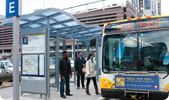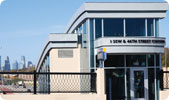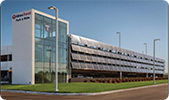We're pioneering a variety of ways to go greener
Since 2008, Metro Transit has invested in energy-saving measures at its facilities that save more than $1 million in utility costs per year. Thanks to the savings, we'll recoup capital costs in less than four years. We've made changes at bus garages to take advantage of new technologies. For example, East Metro Garage, constructed in 2001, is roughly four times more energy efficient than older garages. Other bus garages have been retrofitted with energy-saving improvements such as more efficient lighting, insulated garage doors and digital heating and cooling systems.

In 1991, Metro Transit and its partners pioneered a way to avoid congestion by having buses travel on highway shoulders instead of sitting in rush-hour traffic. Since then, as roadways have been built or reconstructed in the metro region, shoulders are made to accommodate the weight and width of a bus. Buses can use ramp-meter bypasses and travel on shoulders at safe speeds when traffic is at a standstill — saving fuel, reducing emissions and moving customers faster to their destinations.

Marquette and 2nd avenues in Minneapolis were rebuilt in 2009 to accommodate more than 80 percent of downtown express bus traffic. Two bus-only lanes were added to each street that permit buses to pass one another, dramatically reducing idling and nearly doubling bus speeds downtown during the busiest times. Tens of thousands of customers travel through these corridors each weekday.

I-35W & 46th Street Station, which opened in late 2010, uses geothermal energy to assist heating and air conditioning. Pumps send water through tubes 220 feet underground, capturing the earth's temperature to warm it in the winter or cool it in summer. The result provides comfortable temperatures in customer waiting areas. Unlike a facility heated by gas, there are no direct emissions from this station, and geothermal energy dramatically reduces the amount of electricity required.

In 2012, Metro Transit began investing in solar and other renewable sources to help meet the energy needs in its buildings and customer facilities. This investment was in addition to the solar and wind energy the agency already purchased through Xcel Energy. Solar panels now power heating and lighting elements at a growing number of bus shelters and meet – and sometimes exceed – the power needs where they are in use, putting excess energy back on the grid. Metro Transit continues looking up to fuel innovation, with a goal of having nearly half of its electrical load provided through renewable energy by 2025, compared with 27 percent today.
> Efficient ride = greener ride
> Our vehicles
> Additional Metro Transit resources on Rideshare and bicycling